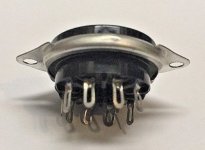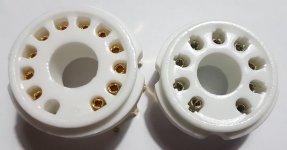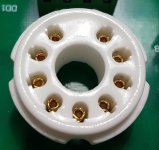Maybe this one......of course I soldered it into the board before I noticed it, then tried to drill it with a PC board bit in a Dremel, resulting in a bit broken off in the socket.
Ya know. That's probably the picture I'm thinking of. Thanks.
Tom
I'm never buying Novar tubes or sockets again. I can't believe they can't put the right terminals in the sockets
I built a 6LR8 spud board nearly 10 years ago when Novar sockets were even harder to find, meaning the Chinese hadn't started making them yet. I waited several months for the first batch of Chinese sockets that ESRC got and put a set in this board. The tubes fit a bit loose, but they didn't fall out when I held the board upside down and shook it.
I then bought a batch of 200 6LR8's cheap and ran them through the board to test them. After about 50 insertions the sockets were junk. I had tightened the pins several times and they were lasting about 3 insertions between tightenings, so I changed them. It would take 3 sets to test 200 tubes.
For that and a few other reasons, I decided not to take the Spud SE any further. The proto board is in a box around here somewhere, but I traded all the 6LR8's for something else that will be seen in another design soon.
I have purchased some Novar sockets from ESRC more recently (maybe 2 years ago) and they are indeed better. It takes a firm hand and a lot of wiggling to force a Magnoval into them, and then it becomes a decent Magnoval socket, but the world's supply of cheap 13GB5's got sucked up by a single buyer in the USA, so that became another dead end.
I have used those sockets with some 6JE6C's and a few other Noval sweep tubes, but I'm still not happy with them. The 12 pin Compactron sockets appear to use the same pins, but there are 12 of them so the tube seems to fit tighter.
The (Ebay) Chinese GD brand B9A Noval sockets have good terminal pins that fit 40 mil tube pins well (tight). And those B9A pins will fit their Magnoval/Novar sockets. But--- the GD Magnoval/Novar sockets come with different (bigger) terminal pins. Sending them messages about putting the B9A pins into the Magnoval/Novar sockets get no where. You must accept their junk sockets. 

Last edited:
Under chasis moumt real Novar sockets.
Hello,
A few weeks I bought one of Tom’s spud boards, then I started looking for tube sockets. I bought a couple under chasis moumt real Novar sockets. From ebay.
Inspired by something I recall seeing at TubeLab.com I will fabracate extensions to the through PCB holes. The PCB will mount to the chasis with the typical PCB spacers.
The extensions will likely be tined 20AWG stranded wire; soldered to the tube pins and the PCB through holes.
DT
Hello,
A few weeks I bought one of Tom’s spud boards, then I started looking for tube sockets. I bought a couple under chasis moumt real Novar sockets. From ebay.
Inspired by something I recall seeing at TubeLab.com I will fabracate extensions to the through PCB holes. The PCB will mount to the chasis with the typical PCB spacers.
The extensions will likely be tined 20AWG stranded wire; soldered to the tube pins and the PCB through holes.
DT
Attachments
The (Ebay) Chinese GD brand B9A Noval sockets have good terminal pins that fit 40 mil tube pins well (tight). And those B9A pins will fit their Magnoval/Novar sockets. But--- the GD Magnoval/Novar sockets come with different (bigger) terminal pins. Sending them messages about putting the B9A pins into the Magnoval/Novar sockets get no where. You must accept their junk sockets.

i used safety pins to make them fit...loosening the old sockets a bit...
with the newer china sockets you can use them on a pl504 or 13gb5 fine, but then using those sockets on other 9 pin types, they are loose....you can only do this once...i sort my china sockets according ly...
Your English is fine. No worries there.
You could connect a vacuum tube rectifier to this board. You can just leave the diodes in place and handle the rectification externally. You'll need a 5 V winding on the transformer to power the rectifier filament. You'd have to play a little with the power transformer and rectifier to get the right B+ voltage. That should not be a big deal.
I'll be happy to help if you go that route.
Tom
You could connect a vacuum tube rectifier to this board. You can just leave the diodes in place and handle the rectification externally. You'll need a 5 V winding on the transformer to power the rectifier filament. You'd have to play a little with the power transformer and rectifier to get the right B+ voltage. That should not be a big deal.
I'll be happy to help if you go that route.
Tom
Your English is fine. No worries there.
You could connect a vacuum tube rectifier to this board. You can just leave the diodes in place and handle the rectification externally. You'll need a 5 V winding on the transformer to power the rectifier filament. You'd have to play a little with the power transformer and rectifier to get the right B+ voltage. That should not be a big deal.
I'll be happy to help if you go that route.
Tom
Hi Tom, thank you for answer, on your site i can see board with diodes - 50$, but I want board which "drawing contacts" for kenotron (vacuum tube rectifier) - three tubes on board (two tubes 6RL8 (or 6GF7A) + one kenotron tube), can you make and sell it for me? Thank You.
PS My grandfather lived in Calgary.
Hi Tom, thank you for answer, on your site i can see board with diodes - 50$, but I want board which "drawing contacts" for kenotron (vacuum tube rectifier) - three tubes on board (two tubes 6RL8 (or 6GF7A) + one kenotron tube), can you make and sell it for me? Thank You.
I charge $125/hour and you're probably looking at at least a day's worth of work.
PS My grandfather lived in Calgary.
Small world.
Tom
Carl Sagan kind of numbers
Tom,
Looking at your signature on these DIY pages and on your web site you use Carl Sagan kind of numbers to report the performance of your creations.
I am sure that you have worked hard to reduce distortion and noise. I am still curious about the lack of prominence of stats that include noise, THD+N and S/N as examples. When noise does get mentioned it is isolated and the measurement is A weighted.
For lower level output devices like headphones it is noise that dominates in stats like THD+N % and S/N.
DT
Tom,
Looking at your signature on these DIY pages and on your web site you use Carl Sagan kind of numbers to report the performance of your creations.
I am sure that you have worked hard to reduce distortion and noise. I am still curious about the lack of prominence of stats that include noise, THD+N and S/N as examples. When noise does get mentioned it is isolated and the measurement is A weighted.
For lower level output devices like headphones it is noise that dominates in stats like THD+N % and S/N.
DT
Actually, I list both the unweighted and A-weighted noise measurements on my website.
I agree that noise matters, especially in headphone applications. Sadly, "HP-1: 3W/20Ω, 450mW/300Ω @ 1.0 uV RMS noise" won't sell headphone amps. Mentioning the THD will. The THD+N of the HP-1 is better than the 112 dB of the APx525, so any THD+N measurement of the HP-1 will just return the THD+N of the APx525. That's why I list THD.
The APx525 is the second best audio analyzer in the world. The only reason I don't have the best in the world, the APx555, is that I can't justify the $32k+ price tag for the base model.
Mentioning S/N doesn't make that much sense to me. An amp that can deliver 100 V swing with 100 uV of noise will have the same SNR as an amp that can deliver 1 V swing with 1 uV of noise. The amp with 100 uV of noise is utterly useless as a headphone amp, though as the noise will drive everybody away.
Tom
I agree that noise matters, especially in headphone applications. Sadly, "HP-1: 3W/20Ω, 450mW/300Ω @ 1.0 uV RMS noise" won't sell headphone amps. Mentioning the THD will. The THD+N of the HP-1 is better than the 112 dB of the APx525, so any THD+N measurement of the HP-1 will just return the THD+N of the APx525. That's why I list THD.
The APx525 is the second best audio analyzer in the world. The only reason I don't have the best in the world, the APx555, is that I can't justify the $32k+ price tag for the base model.
Mentioning S/N doesn't make that much sense to me. An amp that can deliver 100 V swing with 100 uV of noise will have the same SNR as an amp that can deliver 1 V swing with 1 uV of noise. The amp with 100 uV of noise is utterly useless as a headphone amp, though as the noise will drive everybody away.
Tom
Last edited:
SNR measured at 90dB’s inside the headphones
Tom,
Thanks for the straight up candor.
Personally noise and noise BW are the first stats that I am looking for. Next in importance is a noise FFT that will show any spikes in the noise floor. Power line hum/buzz and related harmonics are the worst things to hear in a set of headphones.
For a noise measurement to be useful you need to know BW. For SNR to be meaningful you need to know what the output level is inside the headphones. My preference is SNR measured at 90dB’s inside the headphones.
Over on the Audio Precision site they have a white paper on the ROI (return on investment) for audio analyzers. I am not in this to make money. The price of an APx555 is a sunk cost.
DT
Tom,
Thanks for the straight up candor.
Personally noise and noise BW are the first stats that I am looking for. Next in importance is a noise FFT that will show any spikes in the noise floor. Power line hum/buzz and related harmonics are the worst things to hear in a set of headphones.
For a noise measurement to be useful you need to know BW. For SNR to be meaningful you need to know what the output level is inside the headphones. My preference is SNR measured at 90dB’s inside the headphones.
Over on the Audio Precision site they have a white paper on the ROI (return on investment) for audio analyzers. I am not in this to make money. The price of an APx555 is a sunk cost.
DT
I agree re. noise and hum. There's nothing worse than rectifier buzz in headphones. That's largely a solved problem if you're good at PCB layout, though.
Measuring SNR at a fixed output level would make sense, but that doesn't sell amps. Cranking the output to the max and measuring SNR makes for better numbers, so that's what's done. Basically, it makes the spec meaningless.
ROI on audio analyzers. That's funny. I may have to dig up that paper. I did joke with the AP sales rep (he took me out for dinner), that they could probably make a good bit of money by selling AP logo stamps so people could stamp their measurement graphs.
Tom
Measuring SNR at a fixed output level would make sense, but that doesn't sell amps. Cranking the output to the max and measuring SNR makes for better numbers, so that's what's done. Basically, it makes the spec meaningless.
ROI on audio analyzers. That's funny. I may have to dig up that paper. I did joke with the AP sales rep (he took me out for dinner), that they could probably make a good bit of money by selling AP logo stamps so people could stamp their measurement graphs.
Tom
Here is some summary on converting Magnoval into Novar sockets, as I proposed in #136.
First the photo of pins’ thicknesses, indeed the Magnoval tube would ruin the Novar socket to the unusable degree.
Next, the Compactron vs Magnoval sockets purchased from same GD-parts seller on evil-Bay.
Here are the close-ups of terminals from both, at first I thought the difference should be substantial, but It is.
So I swapped the Magnoval’s terminals with Compactron’s, and the result came out very satisfying. The Novar tube inserts into and sits in it quite tightly, much better than in aka “universal” Novar/Magnoval sockets commonly sold on eBay (tried those too). The only drawback is that the new terminal sits loose in the opening enough to miss it when inserting the tube, so proceed with care. The hint: solder the socket having with a tube inserted – that will make it the better-aligned outcome. Enjoy.
First the photo of pins’ thicknesses, indeed the Magnoval tube would ruin the Novar socket to the unusable degree.
Next, the Compactron vs Magnoval sockets purchased from same GD-parts seller on evil-Bay.
Here are the close-ups of terminals from both, at first I thought the difference should be substantial, but It is.
So I swapped the Magnoval’s terminals with Compactron’s, and the result came out very satisfying. The Novar tube inserts into and sits in it quite tightly, much better than in aka “universal” Novar/Magnoval sockets commonly sold on eBay (tried those too). The only drawback is that the new terminal sits loose in the opening enough to miss it when inserting the tube, so proceed with care. The hint: solder the socket having with a tube inserted – that will make it the better-aligned outcome. Enjoy.
Attachments
Very nice results, thanks for checking that out.
Now if the socket vendors would just sell the Compactron pins separately, or already inserted into the sockets, peace would break out all over the world.....
But, I have tried to enlighten them via messaging several times, and get no where. Wait till they to come out with car tires, one size fits all....
Now if the socket vendors would just sell the Compactron pins separately, or already inserted into the sockets, peace would break out all over the world.....
But, I have tried to enlighten them via messaging several times, and get no where. Wait till they to come out with car tires, one size fits all....
- Status
- This old topic is closed. If you want to reopen this topic, contact a moderator using the "Report Post" button.
- Home
- Vendor's Bazaar
- Novar Spud :: A $200 sweep tube Spud with PCB




